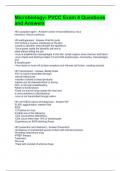Microbiology- PVCC Exam 4 Questions
and Answers
HIV causative agent - Answer-human immunodeficiency virus
retrovirus- Genus Lentivirus
HIV pathogenesis - Answer-Viral life cycle
-HIV enters a mucous membrane or the skin
-travels to dendritic cells beneath the epithelium
-Virus grows inside the dendritic cell and is
shed without killing the cell
-virus is amplified by macrophages in the skin, lymph organs, bone marrow, and blood
-virus infects and destroys helper T4 and CD4 lymphocytes, monocytes, macrophages,
and
B lymphocytes
-virus docks to host cell surface receptors and induces cell fusion, creating syncytia
HIV transmission - Answer-•Bodily fluids
•HIV is mainly transmitted through
-sexual intercourse
-transfer of blood or blood products
-babies can be infected before or during
birth, or through breastfeeding
•Mode of transmission
-Does not survive long outside the host and
is more sensitive to disinfectants
-virus is not transmitted through saliva
HIV and AIDS culture and diagnosis - Answer-HIV
ELISA, agglutination, western blot
AIDS
1) Positive for virus
2) Meet one of the following:
-CD4 count below 200cells/µL
-CD4 count fewer than 14% of lymphocytes
-Experience an AIDS-defining illness
HIV prevention and treatment - Answer-Prevention:
•Avoidance of unprotected sexual contact with infected persons
•Avoiding intravenous drug
•PREP therapy
Treatment:
•No cure
•Treat with cocktail of antiviral drugs
,•HAART (highly active antiretroviral therapy)
•2 reverse transcriptases
•1 protease inhibitor
Endocarditis - signs and symptoms - Answer-fever, anorexia, weight loss, fatigue,
embolic complications, petechiae, splinter hemmorhages, abdominal weakness, edema
of feet/legs, Osler's nodes (painful nodes fingers and toes), Janeway lesions (red
painless skin spots on palms and soles), abdominal or side pain
Endocarditis transmission - Answer-ACUTE: parenteral via direct entry into body-
intravenous and subcutaneous drug users have been growing risk group
traumatic injuries and surgical procedures
SUBACUTE: initial damage to valve allows bacteria attachment
parenteral through vigorous tooth brushing, dental work, minor cuts
Septicemia signs and symptoms - Answer-prominent feature fever, altered mental state,
shaking, chills, gastrointestinal symptoms, increased breath rate, low BP hallmark
cause by inflammation response to infectious agents in the bloodstream, leading to loss
of fluids vasculature, often results in death
septicemia causative agent - Answer-Bacteria! (G+ and G-)
10% fungal cases
Septicemia Pathogenesis and Virulence Factors - Answer--Gram-negative bacteria
multiplying in the blood release large amounts of endotoxin:
•This stimulates a massive inflammatory response mediated by a host of cytokines. This
leads to a drastic drop in blood pressure, a condition known as endotoxic shock.
-Gram-positive bacteria can instigate a similar cascade of events when fragments of the
cell wall are released into the blood.
Septicemia transmission - Answer-direct (parenteral by IV lines or surgical procedures)
serious urinary tract infections, renal, prostatic, pancreatic or gall bladder abscesses
meningitis or pneumonia occasionally lead to sepsis.
Septicemia treatment - Answer-Empiric therapy begins w/ Broad-spectrum antibiotic
until identification and susceptibilities tested, adjust when ID and resistance confirmed
Plague causative agent - Answer-Yersinia pestis, a Gram negative rod; A member of
the Enterobacteriaceae with multiple chromosome and plasmid coded virulence factors
Plague: differentiate between types - Answer-Pneumonic Plague- respiratory disease
Bubonic Plague- inflammation and necrosis of lymph nodes, resulting in a bubo (swollen
lesion), Incubation 2-8 days
Septicemic plague- progression of pneumonic and bubonic into blood, 30-50% treated
die and 100% untreated
, Plague signs and symptoms - Answer-•Pneumonic plague
-respiratory disease
•Bubonic plague
-infection causes inflammation and necrosis of
the lymph node, resulting in a bubo
-swollen lesion (usually in the groin or axilla)
-incubation period lasts 2 - 8 days, ending with
chills fever, headache, nausea weakness, and tenderness of the bubo, mortality rates
are greater than 15%
•Septicemic plague
-pneumonic and bubonic plague often
progress to massive bacterial growth in the
blood
-This results in disseminated intravascular coagulation, subcutaneous hemorrhage, and
purpura, which may degenerate into necrosis and
gangrene
-mortality rates, once the disease reaches this
point, are 30 - 50% with treatment and 100% without treatment
because of the visible darkening of the skin, the plague has often been called "the black
death
Plague transmission - Answer-•Vector: Yersinia pestis, bacteria found in rodents and
Fleas! Bubonic and Septicemic
-Bacteria multiply in gut of flea
-the flea esophagus becomes blocked due
to coagulation factors produced by the pathogen
•Aerosolized droplets: Respiratory and Septicemic. Caused by PERSON TO PERSON
TRANSMISSION
Tularemia (rabbit fever) causative agent - Answer-Francisella tularensis- Gram-negative
rod (Bioterrorism)
Tularemia signs and symptoms - Answer-Incubation: few days- 3 wks
Acute symptoms: backache, chills, fever, malaise and weakness appears
ulcerative skin lesions and swollen lymph nodes at infection site, conjunctival
inflammation, sore throat
Ascending lymphangitis
Death 30%
Tularemia transmission - Answer-vector (tick bites) or aerosolized droplet, direct contact
with infected animals (muskrat or ground squirrel, skinning rabbit (chief way) inhalation,
eating infected meat
Lyme causative agent - Answer-Borrelia burgdorferi
- large spirochete, gram variable
double membrane but lacks LPS




